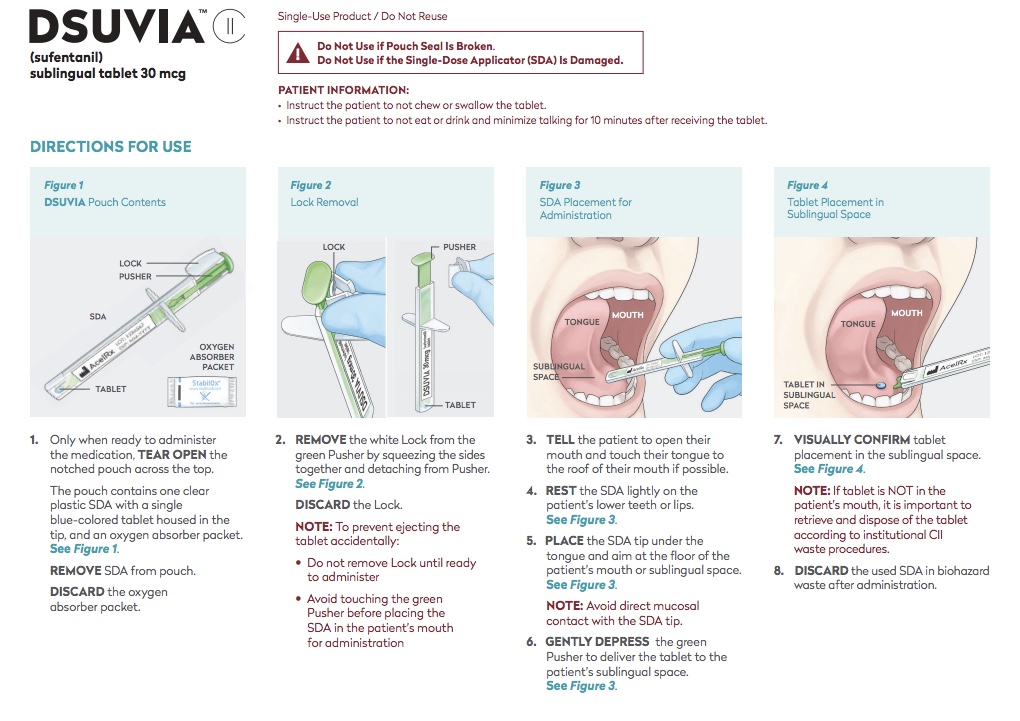How do you take the Dsuvia (sufentanil) tablet?
Medically reviewed by Drugs.com. Last updated on Nov 21, 2024.
Are there any special requirements?
Dsuvia is a sublingual tablet that is placed under the tongue where it dissolves and the medicine is absorbed into the blood.
Dsuvia (sufentanil) from AcelRx Pharmaceuticals is a 30 microgram (mcg) sufentanil tablet in a single-dose, pre-filled applicator.
It is a potent opioid pain medication reserved for patients for whom there are no alternative pain treatment options. It is given under the tongue (sublingual).
- You do not take Dsuvia yourself.
- Dsuvia is given to you by a health care professional and only in a certified, medically-supervised setting (i.e., hospitals, surgical centers, and emergency departments), including use on the battlefield. It is only given via the single-dose applicator. Dsuvia outside of this medically-supervised setting can increase the risk of accidental exposure in others for whom it is not prescribed, causing fatal respiratory depression (slowed or stopped breathing).
- Dsuvia is not available in retail pharmacy settings. Dsuvia is not dispensed directly to patients for use at home and should not be used for more than 72 hours. It is not for use in children.
- Dsuvia contains sufentanil, a Schedule II controlled substance. As an opioid, Dsuvia exposes users to the risks of addiction, abuse, and misuse.
- Specific instructions for health care providers on the sublingual administration of Dsuvia can be found below.

Read next
Naproxen vs ibuprofen: What's the difference?
Ibuprofen is short acting, while naproxen is long acting and more likely to cause an upset stomach. Naproxen also increases the risk of uncontrolled bleeding in people taking blood thinners by 4-fold, and ibuprofen increases the risk 2-fold. Naproxen and ibuprofen are both NSAIDs so they are similar in many ways, but there are important differences. Continue reading
What is low dose naltrexone (LDN)?
Low dose naltrexone means taking a dose of naltrexone that is up to one-tenth, or 10%, of the dose that is usually taken for opioid addiction. A low dose of naltrexone is approximately 4.5mg of naltrexone a day compared with the usual dosage of naltrexone for opioid addiction which is 50mg to 100mg a day. Continue reading
Can you take ibuprofen on an empty stomach?
Despite popular belief that you have to take ibuprofen with food, you can take ibuprofen on an empty stomach and this will give you faster pain relief than taking it with food. Food increases the time it takes for ibuprofen to be absorbed, although it won't affect how much is absorbed. There is actually no evidence that taking ibuprofen with food prevents gastric irritation – ibuprofen at OTC doses has a low incidence of gastric irritation anyway. Continue reading
Related medical questions
- What is the Dsuvia REMS program?
- Is Dsuvia (sufentanil) a controlled substance?
- Meloxicam vs Ibuprofen: What's the difference?
- Aleve vs Ibuprofen: What's the difference?
- Can you take expired ibuprofen?
- What's the difference between aspirin and ibuprofen?
- Can you overdose on ibuprofen?
- Does gabapentin help treat nerve pain?
- Can you take tramadol with acetaminophen, ibuprofen, or aspirin?
- Can you drink alcohol with ibuprofen?
- How do Celebrex and ibuprofen compare?
- Acetaminophen vs paracetamol: What do you need to know?
- Should I take meloxicam at night or in the morning?
- Acetaminophen vs Ibuprofen: Which is better?
- Oxycodone vs Hydrocodone - How do they compare?
- How long can you take Celebrex for?
- Why does my child have leg pain or trouble walking after a fever?
- Tylenol vs Advil: What's the difference?
- What is Metamizole used for?
- CBD Oil: What are 9 Proven or Possible Health Benefits?
- Which painkiller should you use?
- What are the rules for controlled substance prescription refills?
- Can you take ibuprofen 800 mg with tramadol 50 mg?
- How much Tylenol can you take in a day?
- Aleve vs Advil: What's the difference?
- Motrin vs Advil: What's the difference?
- Can ibuprofen cause constipation?
- How long does ibuprofen take to work?
- How long does oxycodone stay in your system?
Drug information
Related support groups
- Dsuvia (3 questions, 3 members)
- Sufentanil (3 questions, 4 members)
- Pain (2,279 questions, 11,940 members)
